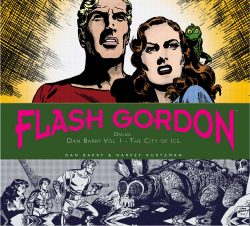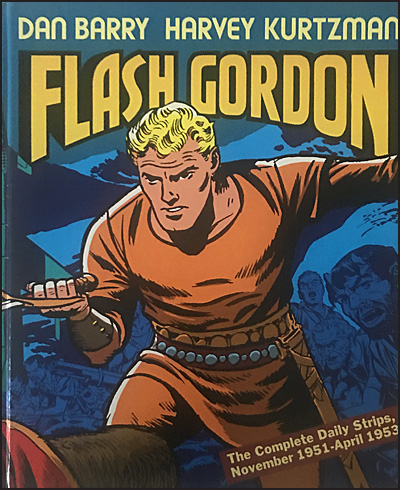

By Hergé, Bob De Moors and others, translated by Leslie Lonsdale-Cooper & Michael Turner (Egmont UK/Farshore)
ISBN: 978-1-40520-815-4 (HB Destination) 978-1-40520-627-3 (TPB Destination)
ISBN: 978-1-40520-816-1 (HB Explorers) 978-1-40520-628-0 (TPB Explorers) Tintin’s Moon Adventure (Magnet/Methuen) ISBN: 978-0-41696-710-4 (TPB)
Tintin on the Moon (Egmont) ISBN: 978-1405295901 (HB)
This book includes Discriminatory Content produced during less enlightened times.
Georges Prosper Remi, known all over the world as Hergé, created a true masterpiece of graphic literature with his tales of a plucky boy reporter and entourage of iconic associates. Initially singly and later with stellar assistants including Edgar P. Jacobs, Bob de Moor and the Hergé Studio, Remi completed 23 splendid volumes (originally produced as episodic instalments for numerous periodicals) which have grown beyond their popular culture roots and attained the status of High Art.
Like Dickens with The Mystery of Edwin Drood, Hergé died working, so final outing Tintin and Alph-Art remains a tale without an official conclusion, but is still a fascinating examination and a pictorial memorial of how the artist worked. It’s only fair though, to ascribe a substantial proportion of credit to the many translators whose diligent contributions have enabled the series to be understood and beloved in more than 70 languages. The subtle, canny, witty and slyly funny English versions are the work of Leslie Lonsdale-Cooper & Michael Turner.
On leaving school in 1925, Remi worked for Catholic newspaper Le XXe Siècle where he apparently fell under the influence of its Svengali-like editor Abbot Norbert Wallez. The following year, the young artist (himself a dedicated boy scout) produced his first strip series – The Adventures of Totor – for monthly Boy Scouts of Belgium magazine. By 1928, he was in charge of producing the contents of Le XXe Siècle’s children’s weekly supplement Le Petit Vingtiéme. Remi was unhappily illustrating The Adventures of Flup, Nènesse and Poussette and Cochonette (written by a staff sports reporter) when Wallez urged the auteur to create an entirely new adventure series. Perhaps a young reporter who would travel the world, doing good whilst displaying solid Catholic values and virtues? Perhaps he might also highlight and expose some of the Faith’s greatest enemies and threats?
Having recently discovered word balloons in imported newspaper strips, Remi opted to incorporate this simple yet effective innovation into his own work, and produced a strip that was both modern and action-packed. Beginning on January 10th 1929, Tintin au pays des Soviets AKA Tintin in the Land of the Soviets changed the comics world. Happy 95th Anniversary, Young Man!
The strip appeared in weekly instalments in Le Petit Vingtiéme, running until May 8th 1930: meaning Tintin remains one of the very first globally successful strip characters, barely preceded by Tarzan and Buck Rogers (both January 7th 1929) and pipping Popeye who only shambled into view on January 17th of that year…
The boy-hero – a combination of Ideal Good Scout and Remi’s own brother Paul (a soldier in the Belgian Army) – would be accompanied by his dog Milou (Snowy to us English speakers) and report back all the inequities from the “Godless Russias”. The strip’s prime conceit was that Tintin was an actual foreign correspondent for Le Petit Vingtiéme and opens with the pair arriving in Russia. The dog and his boy were constantly subject to attacks and tricks by “the Soviets” to prevent the truth of their failed economic progress, specious popular support and wicked global aspirations being revealed to the Free World.
Some of the history beyond that first epic trek is quite dark: During the Nazi Occupation of Belgium, Le Vingtiéme Siècle was closed down and Hergé was compelled to transfer the strip to daily newspaper Le Soir (Brussels’ most prominent French-language periodical, and thus appropriated and controlled by the Nazis). Remi diligently toiled on for the duration, but following Belgium’s liberation was accused of collaboration and being a Nazi sympathiser.
It took the intervention of Belgian Resistance war-hero Raymond Leblanc to dispel the cloud over Hergé, which he did by resolutely vouching for the cartoonist and providing cash to create a new magazine – Le Journal de Tintin – which Leblanc published and managed.
The anthology swiftly achieved a weekly circulation in the hundreds of thousands and enabled the artist and his team to remaster past tales: excising material dictated by and added to ideologically shade war time adventures, as well as generally improving and updating great tales that were about to become a global phenomenon. With WWII over and his reputation restored, Hergé entered the most successful period of his career. He had mastered his storytelling craft, commanded a dedicated audience eager for his every effort and was finally able to say exactly what he wanted in his work, free from fear or censure.
In 1949 he returned to unfinished yarn Tintin au pays de l’or noir – abandoned when the Nazis invaded Belgium. The story had been commissioned by Le Vingtiéme Siècle, running from 28th September 1939 until 8th May 1940 when the paper was shut down. Set on the eve of a European war, the plot revolved around Tintin hunting seditionists and saboteurs tampering with Middle East oil supplies. Before being convinced to update and complete the tale as Land of Black Gold, Hergé briefly toyed with taking his cast into space…
Collected albums Objectif Lune and On a marché sur la Lune were colossal hits after initial serialisation in LJdT from 30th March 1950 – 7th September 1950 and – after what must have been an intolerable wait for readers – from 29th October 1952 – 29th December 1953.
The tale was produced after discussions between Hergé and his friends Bernard Heuvelmans (scientist, author and father of pseudo-science Cryptozoology) and Jacques Van Melkebeke (AKA George Jacquet: strip scripter, painter, journalist and frequent if unacknowledged contributor to Tintin’s canon). The sci fi epic which became a 2-volume masterpiece first made the leap to English in 1959.
On a personal note: I first read Destination Moon in 1964, in a huge hardcover album edition (as they all were in the 1960s) and was blown completely away. I’m happy to say that except for the smaller pages – and there’s never a substitute for “pictorial Big-ness” – this taut thriller and its magnificent, mind-boggling sequel are still in a class of their own in the annals of science fiction comic strips. During the 1980s the entire tale was (repeatedly) released in a combined tome as Tintin’s Moon Adventure: an utterly inescapable piece of publishing common sense. It’s just a shame that it – and all the other the Tintin books – are still not available in digital editions…
Our tale opens with the indomitable boy reporter and Captain Haddock returning to ancestral pile Marlinspike Hall only to discover brilliant but “difficult” savant Professor Cuthbert Calculus has disappeared. When an enigmatic telegram arrives, the puzzled pair are off once again to Syldavia (as seen in King Ottokar’s Sceptre) and a rendezvous with the missing boffin…
Although suspicious, Tintin soon finds the secrecy is for sound reasons. In Syldavia, Calculus and an international team of researchers, engineers and technologists are completing a grand project to put a man on the Moon! In a turbulent race against time and amidst a huge and all-encompassing security clampdown, the scheme nears completion, but Tintin and Haddock’s arrival coincides with a worrying increase in espionage activity.
Some enemy nation or agency is determined to steal the secrets of Calculus’s groundbreaking atomic motor at any cost, and it takes all Tintin’s ingenuity to keep ahead of the villains. The arrival of detectives Thompson and Thomson adds nothing to the aura of anxiety but their bumbling investigations and Calculus’ brief bout of concussion-induced amnesia provide some of the funniest moments in comics history…
As devious incidents and occurrences of sabotage increase in intensity and frequency it becomes clear that there is a traitor inside the project, but at last the moment arrives and Tintin, Haddock, Calculus, technologist Dr. Frank Wolff (and Snowy) blast off for space!
Cold, clinical and superbly underplayed, Destination Moon is completely unlike the flash-and-dazzle razzamatazz of British or American tales from that period – or since. It is as if the burgeoning Cold War mentality of the era infected even Tintin’s bright clean world. Moreover, as before, pressure of work and Hergé’s troubled private life resulted in a breakdown and forced hiatus in the serial, but this time some of that darkness transferred to the material – although it only seems to have added to the overall effect of claustrophobia and paranoia. Even comedy set-pieces are more manic and explosive: despite its fantastic premise, in many ways this is the most mature of all Tintin’s exploits…
Presumably to offset the pressures, the master founded Studio Hergé, beginning on 6th April 1950: a public company to produce The Adventures of Tintin as well other features, with Bob De Moor enthroned as chief apprentice. He became a vital component of Tintin’s gradual domination of the book market: frequently despatched on visual fact-finding missions. De Moor revised the backgrounds of The Black Island for a British edition, repeating the task for a definitive 1971 release of Land of Black Gold. An invaluable and permanent addition to the production team, De Moor supervised and administrated while filling in backgrounds and, most notably, rendering those unforgettably eerie, magnificent Lunar landscapes of the sequel volume.
If the first book is an exercise in tension and suspense, Explorers on the Moon is sheer bravura spectacle. En route to Luna the explorers discover the idiot detectives have stowed away by accident. In conjunction with Captain Haddock’s illicit whisky imbibing and the effects of freefall, Thompson & Thomson provide brilliant comedy routines to balance the pervasive isolation and dramatic dangers of the journey.
Against all odds the lunanauts land safely and make astounding scientific discoveries. We Boomers knew decades ago that there was water on the moon because Tintin and Snowy went skating there! However, the explorations are cut short due to the imminent threat of suffocation after the discovery of another extra passengers on the rocket. Moreover, lurking in the shadows is the very real threat of a murderous traitor to be dealt with…
This so-modern yarn is a high point in the entire Tintin canon, blending heroism and drama with genuine moments of irresistible emotion… and side-splitting comedy. The absolute best of the bunch in my humble opinion, and still one of the most realistic and accurately depicted space comics ever produced. If you only ever read one Hergé saga it simply must be the translunar Adventure of Tintin.
Destination Moon: artwork © 1953, 1959, 1981 Editions Casterman, Paris & Tournai. Text © 1959 Egmont UK Limited. All Rights Reserved. Explorers on the Moon: artwork © 1954, 1959, 1982 Editions Casterman, Paris & Tournai. Text © 1959 Egmont UK Limited. All Rights Reserved.
















